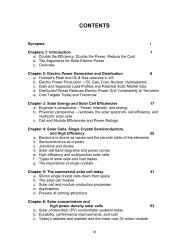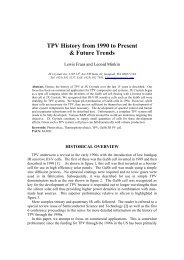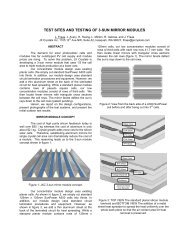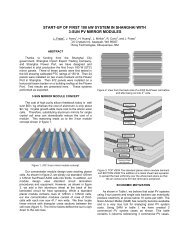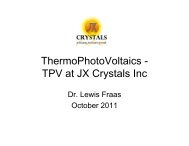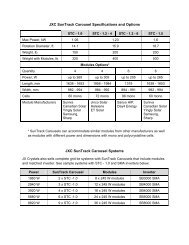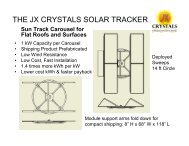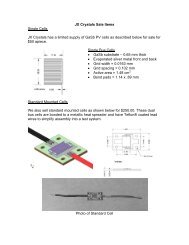TPV GENERATORS USING THE RADIANT TUBE ... - JX Crystals
TPV GENERATORS USING THE RADIANT TUBE ... - JX Crystals
TPV GENERATORS USING THE RADIANT TUBE ... - JX Crystals
Create successful ePaper yourself
Turn your PDF publications into a flip-book with our unique Google optimized e-Paper software.
6. PLANNED IMPROVEMENTSReferring to the PCA shown in figure 8, notice that thesteps in the shingle circuits are clearly visible. It is clearthat there are steps and cracks in the circuits where thereare no filter coatings. Depositing our nine layer filters onglass slides and silicone bonding these glass slides on topof the shingle circuits can cover the steps and cracks. Wehave run a TracePro analysis for two different PCAs withand without planar filters, as summarized in Table II.TracePro analysis shows that an improvement in <strong>TPV</strong>efficiency from 12.8% to 14.4% should result when planarfilters are used. We have fabricated a circuit with planarfilter covers as shown in figure 10 and tested it for output at50 C. The I vs. V results shown in figure 11 indicate thateight of these circuits in a PCA are capable of producing600 Watts of electrical power.Table II: TracePro energy flow and efficiency for PCAwith shingle circuits with steps and cracks vs. PCA withthe same circuits with a planar filter covers.Temitter=1200 C and Tcell=50 C.ShinglecircuitsCircuitswith filtersPCA Ptotal (W) 7,276.4 7,277.8End escape (W) 265.8 340.7Recycled (W) 2,914.6 3,267.7Pmax (W) 557.0 575.0Pwater (W) 4,096.1 3,648.9Ptotal-Precycle (W) 4,361.9 3,990.1Pmax/(Ptotal-Precycle) 12.77% 14.41%Efficiency(burner/recup) 75% 75%Efficiency(system) 9.58% 10.81%Figure 10: Shingle circuit with and without planar filters.7. ECONOMICS AND MARKETSResidential <strong>TPV</strong> systems are replacements for homefurnaces, but offer two significant benefits. First, theelectricity that is generated will offset electric utilitypayments, with a payback period for the <strong>TPV</strong> system ofjust three to five years. And second, <strong>TPV</strong> systems canoperate independent of the electric grid; traditional naturalgas furnaces stop working without electricity for their fans.We forecast that a 1 kW <strong>TPV</strong> cogenerator of heat andelectricity could be sold for $2,000 more than the cost of atraditional furnace with the same heat output. An analysisof natural gas consumption in the central and northeasternUnited States indicates that such a system wouldcogenerate $675 worth of electricity (at 2004 rates), for apayback of three years. In new construction, it would bevery simple to include the capital cost into a home loan,with the annual electric bill savings far outstripping theadditional annual cost on the loan. The additional benefitof reliable heat, even when the power grid is down, isworth at least the cost of traditional 1 kW generators.8. CONCLUSIONSHerein, we have described three <strong>TPV</strong> key componentsthat together represent a novel approach to obtaining high<strong>TPV</strong> conversion efficiency. The newest component is theAR coated refractory metal emitter. A TracePro 3D modelfor a complete system using these components indicatesthat a <strong>TPV</strong> efficiency of 23% should be achievable. Wehave fabricated a radiant tube burner and measured itschemical to radiation efficiency to be 75%. When wesurround this full size burner with a full size AR/W emitterfoil and filter cylinder, operate it at 1275° C, and measurethe output from a single cell, we measure a cell output ofone W/cm 2 which is very consistent with the TraceProprediction. However, there are issues in building a full sizearray that a single cell measurement does not address.We further described the design and fabrication of acomplete <strong>TPV</strong> generator, including a full-size PCA andprovisions for operating the AR/W emitter in an inertatmosphere. Modeling of this system implies that a <strong>TPV</strong>efficiency of 14.4% for a full array should be possibleusing today’s components. This would yield a system fuelto electric efficiency of 10.8%. Higher system efficiency ispossible through an increase in average cell quantumefficiency and/or a decrease in circuit series resistance.REFERENCESPmax = 75.49Vmax = 7.44Imax = 10.15Voc = 10.46Isc = 11.52FF = 0.626Figure 11: I vs. V for circuit with planar filter at 50 C.1. L.M. Fraas, J.E. Avery, V.S. Sundaram, et. al.“Fundamental Characterization Studies of GaSb SolarCells”, 22 nd IEEE PVSC (1991) p. 80.2. US Patents #5,217,539, #5,389,158, #6,057,507,#6,232,545 B1, and PCTs.3. L.M. Fraas, J.E. Samaras, J.E. Avery, andL.M. Minkin, “AR Coated Refractory Metal MatchedEmitter for Use with GaSb <strong>TPV</strong> Generators”,28 th IEEE PVSC (2000) p. 1020.4. US Patent # 6,177,628 and PCT.5. L.M. Fraas et. al., companion paper in this conference.



